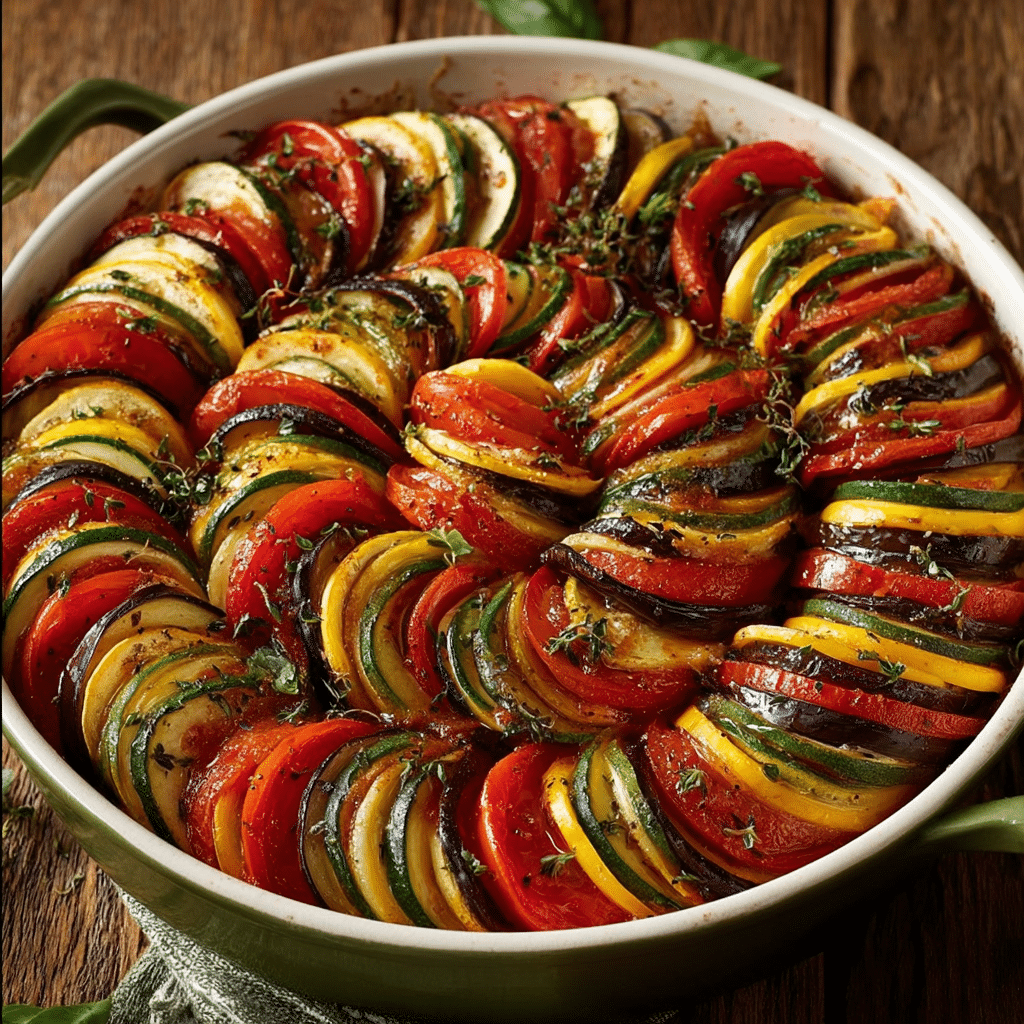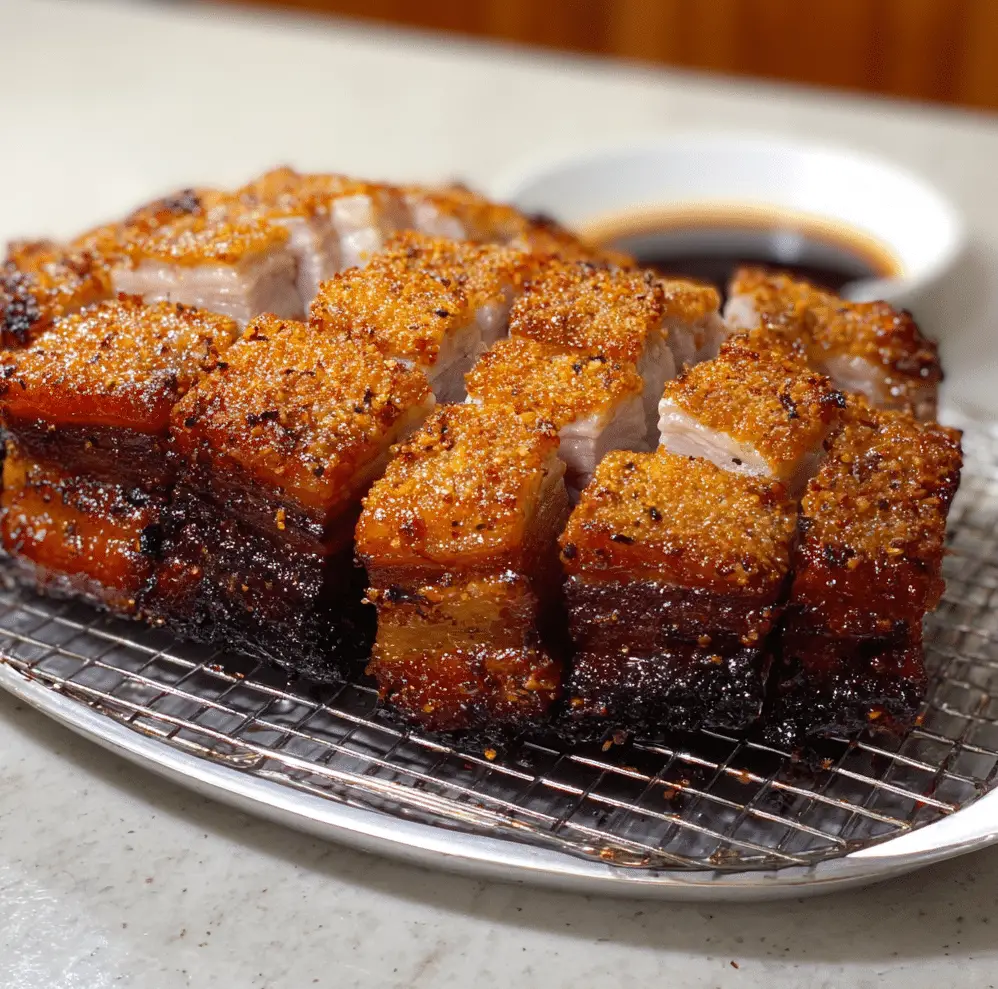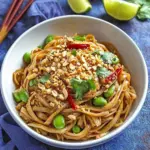The Spiral Ratatouille is not just a dish—it’s a celebration of color, simplicity, and rustic French flavors. With thinly sliced vegetables carefully layered in a stunning spiral atop a bed of rich tomato sauce, this dish is the definition of edible art.
Perfect for late summer meals, this baked vegetable medley makes a delicious centerpiece for any table. It’s naturally vegan, gluten-free, and bursting with Mediterranean charm. Whether you’re hosting dinner or meal-prepping for the week, Spiral Ratatouille offers both elegance and nourishment in every bite.
Full Recipe
Ingredients:
-
1 small eggplant, thinly sliced into rounds
-
2 zucchini, thinly sliced
-
2 yellow squash, thinly sliced
-
3 Roma tomatoes, thinly sliced
-
1 red bell pepper, thinly sliced
-
1 yellow bell pepper, thinly sliced
-
3 tablespoons olive oil
-
2 cloves garlic, minced
-
1 small onion, finely chopped
-
1 cup tomato purée or crushed tomatoes
-
1 teaspoon dried thyme
-
1 teaspoon dried basil
-
Salt and pepper, to taste
-
Fresh basil leaves, for garnish
Directions:
-
Preheat oven to 375°F (190°C).
-
In a skillet, heat 1 tablespoon of olive oil over medium heat. Add onion and garlic, sauté until soft and fragrant, about 3-4 minutes.
-
Stir in the tomato purée, thyme, basil, salt, and pepper. Let simmer for 5 minutes, then pour into the bottom of a round baking dish.
-
Arrange the sliced vegetables in alternating colors (e.g., eggplant, zucchini, squash, tomato, bell pepper) in a spiral pattern over the sauce, starting from the outer edge toward the center.
-
Drizzle the remaining olive oil over the top and season with a little more salt, pepper, and herbs if desired.
-
Cover loosely with parchment paper or foil and bake for 40 minutes. Remove the cover and bake for another 15-20 minutes until vegetables are tender and lightly roasted.
-
Garnish with fresh basil leaves before serving.
Prep Time: 20 minutes | Cooking Time: 60 minutes | Total Time: 1 hour 20 minutes
Kcal: 180 kcal | Servings: 4 servings
The Origins and Cultural Significance of Ratatouille
Ratatouille is a classic dish originating from the Provence region in the south of France. It is renowned for its rustic charm and celebration of fresh, seasonal vegetables. Traditionally, ratatouille was a humble peasant dish made from garden vegetables that were abundant during the summer months. Over time, it has evolved into a beloved staple of French cuisine that showcases the simplicity and natural flavors of vegetables like eggplant, zucchini, tomatoes, and peppers, all enhanced with fragrant herbs.
The dish embodies the essence of Mediterranean cooking: fresh ingredients, healthy fats like olive oil, and aromatic herbs such as thyme and basil. This makes ratatouille not only a flavorful meal but also a nutritionally balanced one, aligned with the principles of the Mediterranean diet, which is often hailed for its benefits to heart health and longevity.
Why Spiral Ratatouille is a Modern Twist
The spiral ratatouille recipe takes this traditional dish and elevates it through visual artistry and presentation. Instead of simply stewing the vegetables, the ingredients are sliced thinly and arranged in a beautiful spiral pattern over a rich tomato sauce base. This technique adds a layer of elegance and sophistication, transforming a rustic vegetable stew into a visually stunning dish worthy of fine dining.
The spiraled presentation also allows the vegetables to roast evenly, preserving their individual textures and flavors rather than blending everything together. This method highlights each vegetable’s unique qualities, from the slightly smoky eggplant to the sweet bell peppers, while the slow roasting melds the flavors gently.
Nutritional Benefits of Ratatouille
Ratatouille is a powerhouse of nutrients, thanks to its vibrant mix of vegetables. Each vegetable contributes valuable vitamins, minerals, and antioxidants that support overall health. Eggplants are rich in fiber and antioxidants such as nasunin, which supports brain health. Zucchini and yellow squash are low in calories but high in vitamins A and C, crucial for immune function and skin health. Tomatoes provide lycopene, a potent antioxidant linked to reducing the risk of certain cancers.
Additionally, the olive oil used in the recipe is a heart-healthy fat, packed with monounsaturated fats and polyphenols that can reduce inflammation and improve cholesterol levels. The herbs add more than flavor—they bring anti-inflammatory and digestive benefits. This combination makes ratatouille an excellent choice for those looking to eat nutrient-dense, whole-food meals.
Variations and Serving Suggestions
One of the great things about ratatouille is its versatility. While the spiral ratatouille emphasizes an artistic presentation, the core ingredients can be adapted based on what you have available or your dietary preferences. Some variations might include adding mushrooms for an earthy flavor, incorporating fresh zucchini blossoms for a gourmet touch, or even layering thin slices of potatoes for extra heartiness.
Ratatouille pairs wonderfully with a variety of accompaniments. It can be served as a main dish alongside crusty French bread or over a bed of creamy polenta or rice for a filling meal. For protein, it pairs beautifully with grilled chicken, fish, or even a poached egg on top. This dish also shines as a side dish at barbecues or dinner parties, providing a colorful, healthy option for guests.
Tips for Perfecting Spiral Ratatouille
Achieving the perfect spiral ratatouille is about balancing technique and timing. First, uniform slicing of the vegetables is essential—not only for aesthetic appeal but also for even cooking. Using a mandoline slicer can make this easier and ensure all slices are the same thickness.
Layering the vegetables tightly in a spiral ensures the dish holds together well during baking and looks impressive when served. It’s important not to overcrowd the dish so that the vegetables roast rather than steam, which brings out deeper caramelized flavors.
The tomato sauce base is another critical component. Using a fresh, homemade tomato sauce with garlic, onions, and herbs creates a flavorful foundation that complements the vegetables. Simmering the sauce ahead of time allows the flavors to develop fully.
Finally, covering the dish with parchment paper or foil during the initial baking helps the vegetables cook through gently without drying out. Removing the cover for the last part of cooking lets the top brown slightly for texture and visual contrast.
The Environmental and Ethical Appeal of Ratatouille
In a world increasingly focused on sustainability and reducing food waste, ratatouille stands out as an eco-friendly meal option. It relies on plant-based ingredients, which generally have a lower environmental footprint than meat-based meals. The flexibility of the recipe allows cooks to use seasonal, local vegetables or whatever is leftover in the fridge, minimizing waste.
By embracing dishes like ratatouille, home cooks can contribute to more sustainable eating habits without sacrificing taste or enjoyment. Plus, plant-forward diets have been shown to support better health outcomes, making ratatouille a win-win for people and the planet.
Conclusion
Spiral ratatouille is a beautiful fusion of tradition and modern culinary art. It takes a beloved Provençal recipe and transforms it into a dish that is not only delicious but visually stunning and nutritious. Its vibrant colors and fresh flavors celebrate the bounty of summer vegetables, while its elegant presentation makes it suitable for both everyday meals and special occasions.
This dish perfectly encapsulates the essence of Mediterranean cooking — simple ingredients, heart-healthy fats, and aromatic herbs — all combined to create a meal that nourishes body and soul. Whether you are a seasoned cook or a beginner, spiral ratatouille offers an accessible way to enjoy wholesome, colorful vegetables in a way that delights the senses.
Embracing recipes like this can inspire more mindful eating, encourage creativity in the kitchen, and foster a deeper appreciation for the seasonal produce that nature provides. Ultimately, spiral ratatouille is more than a meal; it’s an experience, one that brings joy and wellness to the table.








